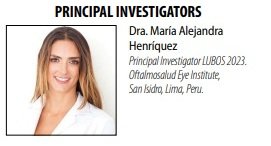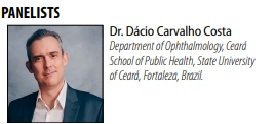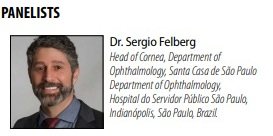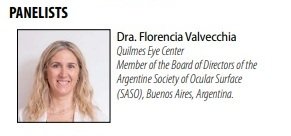Latin American Consensus on Ocular Lubricants and Dry Eye (LUBOS)
DOI:
https://doi.org/10.70313/2718.7446.v17.nS1Eng.383Palabras clave:
película lagrimal, superficie ocular, ojo seco, lágrimas artificiales, lubricantes oculares, consenso, América LatinaResumen
El fluido lagrimal tiene una compleja composición que le permite cumplir múltiples funciones, como por ejemplo ópticas, lubricantes, inmunológicas, endocrinas y neurotróficas, que son indispensables para la salud visual. La alteración de sus componentes, tanto en calidad como en cantidad, afectará su homeostasis repercutiendo también en la superficie ocular, determinando una patología que se llama “ojo seco”. El ojo seco tiene una alta prevalencia global que a su vez se está incrementando por aspectos medioambientales (uso de pantallas principalmente) y también por el aumento de la expectativa de vida. Para su tratamiento existen diversos productos, pero los lubricantes —denominados en forma genérica como “lágrimas artificiales”— resultan fundamentales. Existe una gran variedad de formulaciones lubricantes con diferentes indicaciones que, si se utilizan adecuadamente y acorde con el tipo y grado de severidad del ojo seco, permiten personalizar eficazmente el tratamiento. Considerando la complejidad y la relevancia que tiene este tema, se conformó el Grupo Latinoamericano de Estudio sobre Lubricantes y Ojo Seco (LUBOS). El presente trabajo es un consenso realizado con la finalidad de crear un algoritmo diagnóstico y terapéutico del ojo seco, enfocado en el uso adecuado de lubricantes y que está orientado de forma práctica para el oftalmológico general. Palabras clave: película lagrimal, superficie ocular, ojo seco, lágrimas artificiales, lubricantes oculares, consenso, América Latina.
Descargas
Referencias
Nasa P, Jain R, Juneja D. Delphi methodology in healthcare research: how to decide its appro¬priateness. World J Methodol 2021; 11: 116-129.
Gattrell WT, Hungin AP, Price A et al. AC¬CORD guideline fot reporting consensus-based methods in biomedical research and clinical practice: a study protocol. Res Integr Peer Rev 2022, 7: 3.
Baker A, Young K, Potter J, Madan I. A re¬view of grading system for evidence-based guidelines produced by medical specialties. Clin Med (Lond) 2010; 10: 358-363.
Craig JP, Nelson JD, Azar DT et al. TFOS DEWS II report executive summary. Ocul Surf 2017; 15: 802-812.
Lemp MA. Report of the National Eye Insti¬tute/Industry workshop on clinical trials in dry eyes. CLAO J 1995; 21: 221-332.
The definition and classification of dry eye disease: report of the Definition and Classifi¬cation Subcommittee of the International Drye Eye Workshop (2007). Ocul Surf 2007; 5: 75-92.
Craig JP, Nichols KK, Akpek EK et al. TFOS DEWS II definition and classification report. Ocul Surf 2017; 15: 276-283.
Tsubota K, Yokoi N, Shimazaki J et al. New perspectives on dry eye definition and diagno¬sis: a consensus report by the Asia Dry Eye So¬ciety. Ocul Surf 2017; 15: 65-76.
Akpek EK, Amescua G, American Acade¬my of Ophthalmology Preferred Pactice Pattern Cornea and External Disease Panel et al. Dry eye syndrome Preferred Practice Pattern®. Oph¬thalmology 2019; 126: P286-P334.
Tsubota K, Pflugfelder SC, Liu Z et al. Defin¬ing dry eye from a clinical perspective. Int J Mol Sci 2020 4; 21: 9271.
Rodrigues-Garcia A, Babayan-Sosa A, Ramírez-Miranda A et al. A practical appoach to severity classification and treatment of dry eye disease: a proposal from the Mexican Dry Eye Disease Expert Panel. Clin Ophthalmol 2022; 16: 1331-1355.
Craig JP, Alves M, Wolffsohn JS et al. TFOS lifestyle report introduction: a lifestyle epidem¬ic-ocular surface disease. Ocul Surf 2023; 28: 304-309.
Pflugfelder SC. Antiinflammatory therapy for dry eye. Am J Ophthalmol 2004; 137: 337- 342.
Shimazaki J. Definition and diagnosis of dry eye 2006. Atarashii Ganka 2007; 24:181-184.
Hyon JY, Kim HM, Korean Corneal Disease Study Group et al. Korean guidelines for the di¬agnosis and management of dry eye: develop¬ment and validation of clinical efficacy. Korean J Ophthalmol 2014; 28: 197-206.
Liu, Z. The preliminary recommendations on the name and classification of dry eye. Chin J Eye Otolaryngol 2004; 3: 4-5.
The Chinese Corneal Society. The consen¬sus on clinical diagnosis and treatment of dry eye. Chin J Ophthalmol 2013; 49: 73-75.
Shimazaki J. Definition and diagnostic cri¬teria of dry eye disease: historical overview and future directions. Invest Ophthalmol Vis Sci 2018; 59: DES7-DES12.
Merriam-Webster Dictionary 2016. http:// www.merriam-webster.com
Kannan RJ, Das S, Shetty R et al. Tear pro¬teomics in dry eye disease. Indian J Ophthalmol 2003; 71: 1203-1214.
Jacson CJ, Gundersen KG, Tong L, Utheim TP. Dry eye disease and proteomics. Ocul Surf 2022; 24: 119-128.
Ohashi Y, Ishida R, Kojima T et al. Abnor¬mal protein profiles in tears with dry eye syn¬drome. Am J Ophthalmol 2003; 136: 291-299.
Pflugfelder SC, Jones D, Ji Z et al. Altered cy¬tokine balance in the tear fluid and conjunctiva of patients with Sjögren’s syndrome keratocon¬junctivitis sicca. Curr Eye Res 1999; 19: 201-211.
Enríquez-de-Salamanca A, Castellanos E, Stern ME et al. Tear cytokine and chemokine analysis and clinical correlations in evapora¬tive-type dry eye disease. Mol Vis 2010; 16: 862- 873.
Solomon A, Dursun D, Liu Z et al. Pro- and anti-inflammatory forms of interleukin-1 in the tear fluid and conjunctiva of patients with dry-eye disease. Invest Ophthalmol Vis Sci 2001; 42: 2283-2292.
Yoon KC, Jeong IY, Park YG, Yang SY. Inter¬leukin-6 and tumor necrosis factor-alpha levels in tears of patients with dry eye syndrome. Cor¬nea 2007; 26: 431-437.
Tishler M, Yaron I, Geyer O et al. Elevated tear interleukin-6 levels in patients with Sjögren syndrome. Ophthalmology 1998; 105: 2327- 2379.
Danjo Y, Lee M, Horimoto K, Hamano T. Oc¬ular surface damage and tear lactoferrin in dry eye syndrome. Acta Ophthalmol (Copenh) 1994; 72: 433-437.
Navone R, Lunardi C, Gerli R et al. Identifi¬cation of tear lipocalin as a novel autoantigen tar¬get in Sjögren’s syndrome. J Autoimmun 2005; 25: 229-234.
Yamada M, Mochizuki H, Kawai M et al. De¬creased tear lipocalin concentration in patients with meibomian gland dysfunction. Br J Ophthal¬mol 2005; 89: 803-805.
Schlegel I, De Goüyon Matignon de Pon¬tourade CMF, Lincke JB et al. The human ocu¬lar surface microbiome and its associations with the tear proteome in dry eye disease. Int J Mol Sci 2023; 24: 14091.
Zhao H, Jumblatt JE, Wood TO, Jumblatt MM. Quantification of MUC5AC protein in hu¬man tears. Cornea 2001; 20: 873-877.
Virtanen T, Konttinen YT, Honkanen N et al. Tear fluid plasmin activity of dry eye patients with Sjögren’s syndrome. Acta Ophthalmol Scand 1997; 75: 137-141.
Aho VV, Nevalainen TJ, Saari KM. Group IIA phospholipase A2 content of basal, nonstimulated and reflex tears. Curr Eye Res 2002; 24: 224-227.
Chen D, Wei Y, Li X et al. sPLA2-IIa is an in¬flammatory mediator when the ocular surface is compromised. Exp Eye Res 2009; 88: 880-888.
Jung GT, Kim M, Song JS et al. Proteomic analysis of tears in dry eye disease: a prospective, double-blind multicenter study. Ocul Surf 2023; 29: 68-76.
Koduri MA, Prasad D, Pingali T et al. Optimi¬zation and evaluation of tear protein elution from Schirmer’s strips in dry eye disease. Indian J Oph¬thalmol 2023; 71: 1413-1419.
Peral A, Carracedo G, Acosta MC et al. In¬creased levels of diadenosine polyphosphates in dry eye. Invest Ophthalmol Vis Sci 2006; 47: 4053- 4058.
Potvin R, Makari S, Rapuano CJ. Tear film os¬molarity and dry eye disease: a review of the liter¬ature. Clin Ophthalmol 2015; 9: 2039-2047.
Bron AJ, de Paiva CS, Chauhan SK et al. TFOS DEWS II pathophysiology report. Ocul Surf 2017; 15: 438-510.
Sheppard JD, Nichols KK. Dry eye disease associated with meibomian gland dysfunction: focus on tear film characteristics and the ther¬apeutic landscape. Ophthalmol Ther 2023; 12: 1397-1418.
Lam SM, Tong L, Reux B et al. Lipidom¬ic analysis of human tear fluid reveals struc¬ture-specific lipid alterations in dry eye sín¬drome. J Lipid Res 2014; 55: 299-306.
Barbosa EB, Tavares CM, da Silva DFL et al. Characterization of meibomian gland dysfunc¬tion in patients with rosacea. Arq Bras Oftal¬mol 2023; 86: 365-371.
Wang LX, Deng YP. Androgen and meibo¬mian gland dysfunction: from basic molecular biology to clinical applications. Int J Ophthalmol 2021; 14: 915-922.
Fischer FH, Wiederholt M. Human precor¬neal tear film pH measured by microelectrodes. Graefes Arch Clin Exp Ophthalmol 1982; 218: 168-170.
Descargas
Publicado
Número
Sección
Licencia
Derechos de autor 2024 Consejo Argentino de Oftalmología

Esta obra está bajo una licencia internacional Creative Commons Atribución-NoComercial-SinDerivadas 4.0.
Con esta licencia no se permite un uso comercial de la obra original, ni la generación de obras derivadas. Las licencias Creative Commons permiten a los autores compartir y liberar sus obras en forma legal y segura.








































